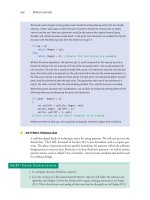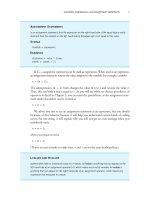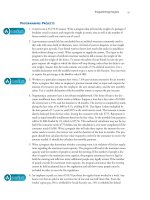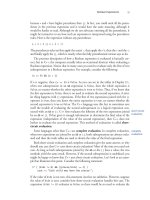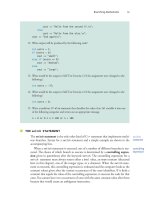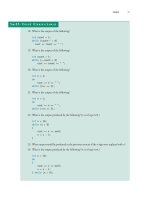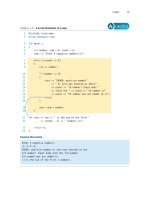Absolute C++ (4th Edition) part 12 pps
Bạn đang xem bản rút gọn của tài liệu. Xem và tải ngay bản đầy đủ của tài liệu tại đây (168.42 KB, 10 trang )
112 Function Basics
Notice that the function call ends with a semicolon, which tells the compiler that the
function call is an executable statement.
When a
void function is called, the arguments are substituted for the formal param-
eters, and the statements in the function body are executed. For example, a call to the
void function showResults, which we gave earlier in this section, will cause some out-
put to be written to the screen. One way to think of a call to a
void function is to imag-
ine that the body of the function definition is copied into the program in place of the
function call. When the function is called, the arguments are substituted for the formal
parameters, and then it is just as if the body of the function were lines in the program.
(Chapter 4 describes the process of substituting arguments for formal parameters in
detail. Until then, we will use only simple examples that should be clear enough with-
out a formal description of the substitution process.)
It is perfectly legal, and sometimes useful, to have a function with no arguments. In
that case there simply are no formal parameters listed in the function declaration and
no arguments are used when the function is called. For example, the
void function
initializeScreen, defined below, simply sends a newline command to the screen:
void initializeScreen( )
{
cout << endl;
}
If your program includes the following call to this function as its first executable state-
ment, then the output from the previously run program will be separated from the out-
put for your program:
initializeScreen( );
Be sure to notice that even when there are no parameters to a function, you still must
include the parentheses in the function declaration and in a call to the function.
Placement of the function declaration (function prototype) and the function defini-
tion is the same for
void functions as what we described for functions that return a
value.
■ return
STATEMENTS IN
void
FUNCTIONS
Both void functions and functions that return a value can have return statements. In
the case of a function that returns a value, the
return statement specifies the value
returned. In the case of a
void function, the return statement does not include any
expression for a value returned. A
return statement in a void function simply ends the
function call. Every function that returns a value must end by executing a
return state-
ment. However, a
void function need not contain a return statement. If it does not
contain a
return statement, it will end after executing the code in the function body. It
is as if there were an implicit
return statement just before the final closing brace, }, at
the end of the function body.
functions with
no arguments
void
functions and
return
statements
Programmer-Defined Functions 113
The fact that there is an implicit return statement before the final closing brace in a
function body does not mean that you never need a
return statement in a void func-
tion. For example, the function definition in Display 3.7 might be used as part of a res-
taurant-management program. That function outputs instructions for dividing a given
amount of ice cream among the people at a table. If there are no people at the table
(that is, if
number equals 0), then the return statement within the if statement termi-
nates the function call and avoids a division by zero. If
number is not 0, then the func-
tion call ends when the last
cout statement is executed at the end of the function body.
■
PRECONDITIONS AND POSTCONDITIONS
One good way to write a function declaration comment is to break it down into two
kinds of information called the precondition and the postcondition. The precondition
states what is assumed to be true when the function is called. The function should not be
used and cannot be expected to perform correctly unless the precondition holds. The
postcondition describes the effect of the function call; that is, the postcondition tells
what will be true after the function is executed in a situation in which the precondition
holds. For a function that returns a value, the postcondition will describe the value
F
UNCTION
D
ECLARATION
(F
UNCTION
P
ROTOTYPE
)
A function declaration (function prototype) tells you all you need to know to write a call to the
function. A function declaration (or the full function definition) must appear in your code prior to
a call to the function. Function declarations are normally placed before the
main part of your
program.
S
YNTAX
Type_Returned_Or_void FunctionName
(
Parameter_List
);
where the
Parameter_List
is a comma-separated list of parameters:
Type_1 Formal_Parameter_1
,
Type_2 Formal_Parameter_2
,
,
Type_Last Formal_Parameter_Last
E
XAMPLES
double totalWeight(int number, double weightOfOne);
//Returns the total weight of number items that
//each weigh weightOfOne.
void showResults(double fDegrees, double cDegrees);
//Displays a message saying fDegrees Fahrenheit
//is equivalent to cDegrees Celsius.
Do not forget
this semicolon.
precondition
post-
condition
114 Function Basics
Display 3.7 Use of return in a void Function
1 #include <iostream>
2 using namespace std;
3 void iceCreamDivision(int number, double totalWeight);
4 //Outputs instructions for dividing totalWeight ounces of ice cream among
5 //number customers. If number is 0, only an error message is output.
6 int main( )
7 {
8 int number;
9 double totalWeight;
10 cout << "Enter the number of customers: ";
11 cin >> number;
12 cout << "Enter weight of ice cream to divide (in ounces): ";
13 cin >> totalWeight;
14 iceCreamDivision(number, totalWeight);
15 return 0;
16 }
17 void iceCreamDivision(int number, double totalWeight)
18 {
19 double portion;
20 if (number == 0)
21 {
22 cout << "Cannot divide among zero customers.\n";
23 return;
24 }
25 portion = totalWeight/number;
26 cout << "Each one receives "
27 << portion << " ounces of ice cream." << endl;
28 }
S
AMPLE
D
IALOGUE
Enter the number of customers: 0
Enter weight of ice cream to divide (in ounces): 12
Cannot divide among zero customers.
If number is 0, then the
function execution ends here.
Programmer-Defined Functions 115
returned by the function. For a function that changes the value of some argument vari-
ables, the postcondition will describe all the changes made to the values of the arguments.
For example, the following is a function declaration with precondition and post-
condition:
void showInterest(double balance, double rate);
//Precondition: balance is a nonnegative savings account balance.
//rate is the interest rate expressed as a percentage, such as 5 for 5%.
//Postcondition: The amount of interest on the given balance
//at the given rate is shown on the screen.
You do not need to know the definition of the function showInterest in order to use
this function. All that you need to know in order to use this function is given by the
precondition and postcondition.
When the only postcondition is a description of the value returned, programmers
usually omit the word
Postcondition, as in the following example:
double celsius(double fahrenheit);
//Precondition: fahrenheit is a temperature in degrees Fahrenheit.
//Returns the equivalent temperature expressed in degrees Celsius.
Some programmers choose not to use the words precondition and postcondition in
their function comments. However, whether you use the words or not, you should
always think in terms of precondition and postcondition when designing a function
and when deciding what to include in the function comment.
■ main
IS A FUNCTION
As we already noted, the main part of a program is actually the definition of a function
called
main. When the program is run, the function main is automatically called; it, in
turn, may call other functions. Although it may seem that the
return statement in the
main part of a program should be optional, practically speaking it is not. The C++ stan-
dard says that you can omit the
return 0 statement in the main part of the program,
but many compilers still require it and almost all compilers allow you to include it. For
the sake of portability, you should include
return 0 statement in the main function.
You should consider the
main part of a program to be a function that returns a value of
type
int and thus requires a return statement. Treating the main part of your program
as a function that returns an integer may sound strange, but that’s the tradition which
many compilers enforce.
Although some compilers may allow you to get away with it, you should not include
a call to
main in your code. Only the system should call main, which it does when you
run your program.
116 Function Basics
Self-Test Exercises
■
RECURSIVE FUNCTIONS
C++ does allow you to define recursive functions. Recursive functions are covered in
Chapter 13. If you do not know what recursive functions are, there is no need to be
concerned until you reach that chapter. If you want to read about recursive functions
early, you can read Sections 13.1 and 13.2 of Chapter 13 after you complete Chapter 4.
Note that the
main function should not be called recursively.
15. What is the output of the following program?
#include <iostream>
using namespace std;
void friendly( );
void shy(int audienceCount);
int main( )
{
friendly( );
shy(6);
cout << "One more time:\n";
shy(2);
friendly( );
cout << "End of program.\n";
return 0;
}
void friendly( )
{
cout << "Hello\n";
}
void shy(int audienceCount)
{
if (audienceCount < 5)
return;
cout << "Goodbye\n";
}
16. Suppose you omitted the return statement in the function definition for iceCreamDivi-
sion
in Display 3.7. What effect would it have on the program? Would the program com-
pile? Would it run? Would the program behave any differently?
17. Write a definition for a
void function that has three arguments of type int and that out-
puts to the screen the product of these three arguments. Put the definition in a complete
program that reads in three numbers and then calls this function.
Scope Rules 117
18. Does your compiler allow void main( ) and int main( )? What warnings are issued if
you have
int main( ) and do not supply a return 0; statement? To find out, write sev-
eral small test programs and perhaps ask your instructor or a local guru.
19. Give a precondition and a postcondition for the predefined function
sqrt, which returns
the square root of its argument.
Scope Rules
Let the end be legitimate, let it be within the scope of the
constitution, . . .
John Marshall, Chief Justice U.S. Supreme Court,
McCulloch v. Maryland (1803)
Functions should be self-contained units that do not interfere with other functions—
or any other code for that matter. To achieve this you often need to give the function
variables of its own that are distinct from any other variables that are declared outside
the function definition and that may have the same names as the variables that belong
to the function. These variables that are declared in a function definition are called local
variables and are the topic of this section.
■
LOCAL VARIABLES
Look back at the program in Display 3.1. It includes a call to the predefined function
sqrt. We did not need to know anything about the details of the function definition
for
sqrt in order to use this function. In particular, we did not need to know what vari-
ables were declared in the definition of
sqrt. A function that you define is no different.
Variable declarations within a function definition are the same as if they were variable
declarations in a predefined function or in another program. If you declare a variable in
a function definition and then declare another variable of the same name in the
main
function of the program (or in the body of some other function definition), then these
two variables are two different variables, even though they have the same name. Let’s
look at an example.
The program in Display 3.8 has two variables named
averagePea; one is declared
and used in the function definition for the function
estimateOfTotal, and the other is
declared and used in the
main function of the program. The variable averagePea in the
function definition for
estimateOfTotal and the variable averagePea in the main func-
tion are two different variables. It is the same as if the function
estimateOfTotal were
a predefined function. The two variables named
averagePea will not interfere with
each other any more than two variables in two completely different programs would.
3.3
118 Function Basics
Display 3.8 Local Variables
(part 1 of 2)
1 //Computes the average yield on an experimental pea growing patch.
2 #include <iostream>
3 using namespace std;
4 double estimateOfTotal(int minPeas, int maxPeas, int podCount);
5 //Returns an estimate of the total number of peas harvested.
6 //The formal parameter podCount is the number of pods.
7 //The formal parameters minPeas and maxPeas are the minimum
8 //and maximum number of peas in a pod.
9 int main( )
10 {
11 int maxCount, minCount, podCount;
12 double averagePea, yield;
13 cout << "Enter minimum and maximum number of peas in a pod: ";
14 cin >> minCount >> maxCount;
15 cout << "Enter the number of pods: ";
16 cin >> podCount;
17 cout << "Enter the weight of an average pea (in ounces): ";
18 cin >> averagePea;
19 yield =
20 estimateOfTotal(minCount, maxCount, podCount) * averagePea;
21 cout.setf(ios::fixed);
22 cout.setf(ios::showpoint);
23 cout.precision(3);
24 cout << "Min number of peas per pod = " << minCount << endl
25 << "Max number of peas per pod = " << maxCount << endl
26 << "Pod count = " << podCount << endl
27 << "Average pea weight = "
28 << averagePea << " ounces" << endl
29 << "Estimated average yield = " << yield << " ounces"
30 << endl;
31 return 0;
32 }
33
34 double estimateOfTotal(int minPeas, int maxPeas, int podCount)
35 {
36 double averagePea;
37 averagePea = (maxPeas + minPeas)/2.0;
38 return (podCount * averagePea);
39 }
This variable named
averagePea is local to the
main function.
This variable named
averagePea is local to
the function
estimateOfTotal.
Scope Rules 119
When the variable averagePea is given a value in the function call to estimateOfTotal,
this does not change the value of the variable in the
main function that is also named
averagePea.
Variables that are declared within the body of a function definition are said to be
local to that function or to have that function as their scope. If a variable is local to
some function, we sometimes simply call it a local variable, without specifying the
function.
Another example of local variables can be seen in Display 3.5. The definition of the
function
totalCost in that program begins as follows:
double totalCost(int numberParameter, double priceParameter)
{
const double TAXRATE = 0.05; //5% sales tax
double subtotal;
The variable subtotal is local to the function totalCost. The named constant TAXRATE
is also local to the function totalCost. (A named constant is in fact nothing but a vari-
able that is initialized to a value and that cannot have that value changed.)
L
OCAL
V
ARIABLES
Variables that are declared within the body of a function definition are said to be
local to that
function
or to have that function as their
scope
. If a variable is local to a function, then you can
have another variable (or other kind of item) with the same name that is declared in another func-
tion definition; these will be two different variables, even though they have the same name. (In
particular, this is true even if one of the functions is the
main function.)
D
i
sp
l
ay 3.8 Local Variables
(
part 2 of 2
)
S
AMPLE
D
IALOGUE
Enter minimum and maximum number of peas in a pod: 4 6
Enter the number of pods: 10
Enter the weight of an average pea (in ounces): 0.5
Min number of peas per pod = 4
Max number of peas per pod = 6
Pod count = 10
Average pea weight = 0.500 ounces
Estimated average yield = 25.000 ounces
local
variable
scope
120 Function Basics
■
PROCEDURAL ABSTRACTION
A person who uses a program should not need to know the details of how the program
is coded. Imagine how miserable your life would be if you had to know and remember
the code for the compiler you use. A program has a job to do, such as compiling your
program or checking the spelling of words in your paper. You need to know what the
program’s job is so that you can use the program, but you do not (or at least should
not) need to know how the program does its job. A function is like a small program and
should be used in a similar way. A programmer who uses a function in a program needs
to know what the function does (such as calculate a square root or convert a tempera-
ture from degrees Fahrenheit to degrees Celsius), but should not need to know how the
function accomplishes its task. This is often referred to as treating the function like a
black box.
Calling something a black box is a figure of speech intended to convey the image of
a physical device that you know how to use but whose method of operation is a mys-
tery because it is enclosed in a black box that you cannot see inside of (and cannot pry
open). If a function is well designed, the programmer can use the function as if it were
a black box. All the programmer needs to know is that if he or she puts appropriate
arguments into the black box, then it will take some appropriate action. Designing a
function so that it can be used as a black box is sometimes called information hiding
to emphasize the fact that the programmer acts as if the body of the function were hid-
den from view.
Writing and using functions as if they were black boxes is also called procedural
abstraction. When programming in C++ it might make more sense to call it func-
tional abstraction. However, procedure is a more general term than function and com-
puter scientists use it for all “function-like” sets of instructions, and so they prefer the
P
ROCEDURAL
A
BSTRACTION
When applied to a function definition, the principle of
procedural abstraction
means that your
function should be written so that it can be used like a black box
. This means that the program-
mer who uses the function should not need to look at the body of the function definition to see
how the function works. The function declaration and the accompanying comment should be all
the programmer needs to know in order to use the function. To ensure that your function defini-
tions have this important property, you should strictly adhere to the following rules:
H
OW
TO
W
RITE
A
B
LACK
-B
OX
F
UNCTION
D
EFINITION
■ The function declaration comment should tell the programmer any and all conditions that are
required of the arguments to the function and should describe the result of a function invocation.
■ All variables used in the function body should be declared in the function body. (The formal
parameters do not need to be declared, because they are listed in the function heading.)
black box
information
hiding
procedural
abstraction
Scope Rules 121
term procedural abstraction. The term abstraction is intended to convey the idea that
when you use a function as a black box, you are abstracting away the details of the code
contained in the function body. You can call this technique the black box principle or
the principle of procedural abstraction or information hiding. The three terms mean the
same thing. Whatever you call this principle, the important point is that you should
use it when designing and writing your function definitions.
■
GLOBAL CONSTANTS AND GLOBAL VARIABLES
As we noted in Chapter 1, you can and should name constant values using the const
modifier. For example, in Display 3.5 we used the const modifier to give a name to the
rate of sales tax with the following declaration:
const double TAXRATE = 0.05; //5% sales tax
If this declaration is inside the definition of a function, as in Display 3.5, then the
name
TAXRATE is local to the function definition, which means that outside the defini-
tion of the function that contains the declaration, you can use the name
TAXRATE for
another named constant, or variable, or anything else.
On the other hand, if this declaration were to appear at the beginning of your pro-
gram, outside the body of all the functions (and outside the body of the
main part of
your program), then the named constant is said to be a global named constant and
the named constant can be used in any function definition that follows the constant
declaration.
Display 3.9 shows a program with an example of a global named constant. The pro-
gram asks for a radius and then computes both the area of a circle and the volume of a
sphere with that radius, using the following formulas:
area
= π x (
radius
)
2
volume
= (4/3) x π x (
radius
)
3
Both formulas include the constant π, which is approximately equal to 3.14159. The
symbol
π is the Greek letter called “pi.” The program thus uses the following global
named constant:
const double PI = 3.14159;
which appears outside the definition of any function (including outside the definition
of
main).
The compiler allows you wide latitude in where you place the declarations for your
global named constants. To aid readability, however, you should place all your
include
directives together, all your global named constant declarations together in another
group, and all your function declarations (function prototypes) together. We will fol-
low standard practice and place all our global named constant declarations after our
include and using directives and before our function declarations.
global
named
constant
